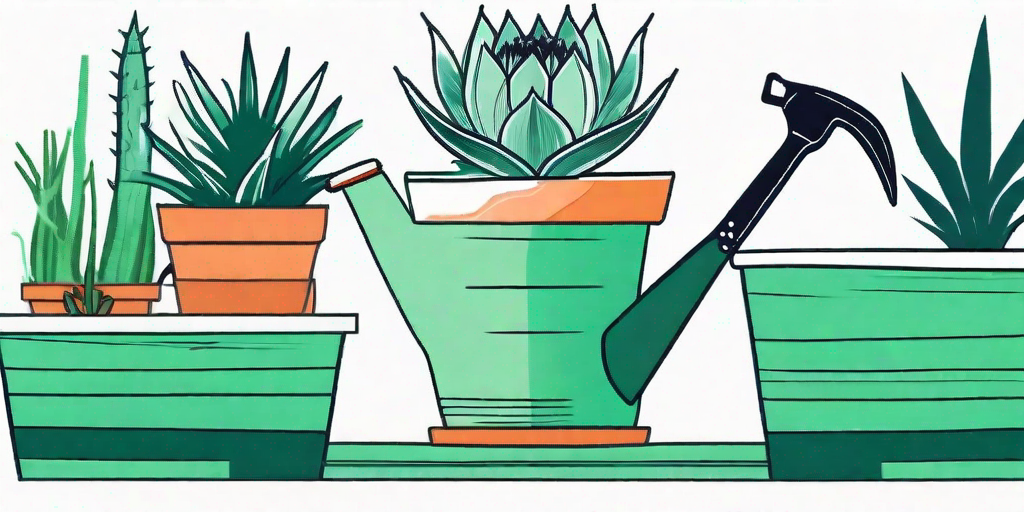
Welcome to the world of agave plant parenthood! You've made a wise decision, my friend. Agaves are the rockstars of the succulent world, known for their resilience, low maintenance, and striking appearance. But like any rockstar, they need a little TLC to truly shine. So, buckle up and get ready for a wild ride into the world of agave care!
Understanding Your Agave: It's Not Just a Plant, It's a Lifestyle
First things first, let's get to know your agave. Agaves are native to the arid and semi-arid regions of the Americas. They're used to roughing it out in the wild, so they're pretty tough cookies. But don't let their tough exterior fool you. They have a soft heart... well, a soft core, to be precise.
Agaves come in a variety of shapes, sizes, and colors. Some are small enough to fit on your windowsill, while others can grow as tall as a person. Some are green, some are blue, and some are variegated. But no matter what they look like, all agaves have one thing in common: they're absolute showstoppers.
The Agave Life Cycle
Agaves have a unique life cycle. They grow slowly, taking their sweet time to reach maturity. But once they do, boy, do they go out with a bang! Most agaves bloom only once in their lifetime, producing a tall flower stalk that can reach up to 30 feet in height. After blooming, the plant dies, leaving behind pups or offsets that continue the cycle. It's a bit dramatic, but hey, that's rockstars for you!
Understanding the agave life cycle is crucial for proper care. You wouldn't want to miss your agave's once-in-a-lifetime performance, would you?
How to Care for Your Agave: The Basics
Now that we've covered the basics of agave biology, let's move on to the nitty-gritty: agave care. Don't worry, it's not as complicated as it sounds. With a few simple tips and tricks, you'll be an agave whisperer in no time.
Light Requirements
Agaves love the sun. They need at least six hours of direct sunlight each day to thrive. If you're growing your agave indoors, place it near a south-facing window to ensure it gets enough light. If your agave starts to look pale or stretched out, it's probably not getting enough light.
But remember, not all agaves are created equal. Some agaves can tolerate full sun, while others prefer a bit of afternoon shade. It's always a good idea to research the specific light requirements of your agave species.
Watering Your Agave
When it comes to watering, less is more. Agaves are drought-tolerant plants that can survive long periods without water. Overwatering is a common mistake among new agave parents, and it can lead to root rot, a deadly condition for agaves.
The key to watering your agave is to wait until the soil is completely dry before watering again. In the summer, this might mean watering once a week. In the winter, you might only need to water once a month. Again, it's important to research the specific watering needs of your agave species.
Advanced Agave Care: Taking Your Agave Parenthood to the Next Level
So, you've mastered the basics of agave care. Congratulations! But don't rest on your laurels just yet. There's always more to learn in the world of agave parenthood.
Propagating Your Agave
Propagating your agave is a great way to expand your collection and share the agave love with friends and family. The easiest way to propagate an agave is by removing and replanting the pups or offsets that grow around the base of the plant. Just make sure to let the cuttings dry for a few days before planting to prevent root rot.
Some agaves can also be propagated from seed, but this requires a bit more patience and skill. If you're up for the challenge, go for it! There's nothing more rewarding than watching a tiny seed grow into a beautiful agave.
Dealing with Pests and Diseases
Agaves are generally pest-resistant, but they're not invincible. Common pests include mealybugs, scale, and agave snout weevils. If you notice any unusual spots or growths on your agave, it's best to take action immediately. Most pests can be controlled with insecticidal soap or neem oil.
As for diseases, the most common is root rot, usually caused by overwatering. If your agave starts to wilt or turn yellow, check the roots for signs of rot. If you catch it early, you might be able to save your agave by repotting it in fresh, well-draining soil.
Frequently Asked Questions
Why is my agave turning yellow?
Yellow leaves are usually a sign of overwatering. Check the soil to see if it's waterlogged. If it is, you might need to repot your agave in fresh, well-draining soil.
Can I grow an agave from seed?
Yes, you can! But keep in mind that it's a slow process. Agave seeds can take anywhere from a few weeks to a few months to germinate, and the seedlings grow very slowly. But if you're patient, growing an agave from seed can be a rewarding experience.
How often should I repot my agave?
Agaves don't need to be repotted very often. In fact, they prefer to be a bit root-bound. As a general rule, you should only repot your agave when it outgrows its pot or when the soil becomes depleted or waterlogged.
Conclusion
And there you have it, folks! Everything you need to know to become a successful agave parent. Remember, agave care is not a one-size-fits-all kind of deal. Each agave species has its own unique needs and preferences. But with a little research and a lot of love, you can raise a happy and healthy agave. So, what are you waiting for? Get out there and start living the agave lifestyle!















